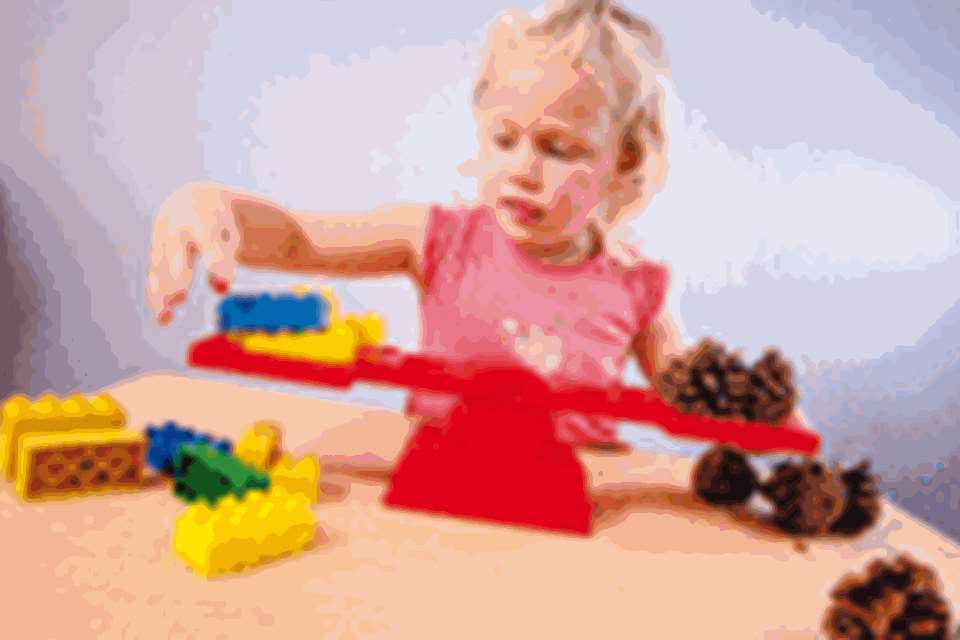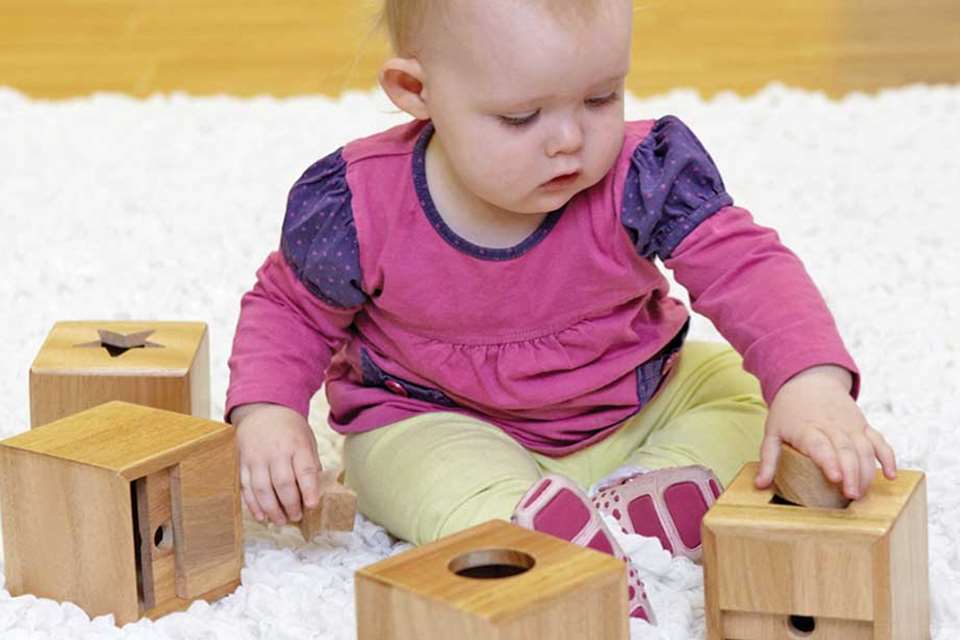Enabling Environments: Collections - Try for size
Ruth Thomson
Monday, December 16, 2013
An understanding of size aids mathematical development in children, but how can you support it? Nicole Weinstein offers some suggestions.
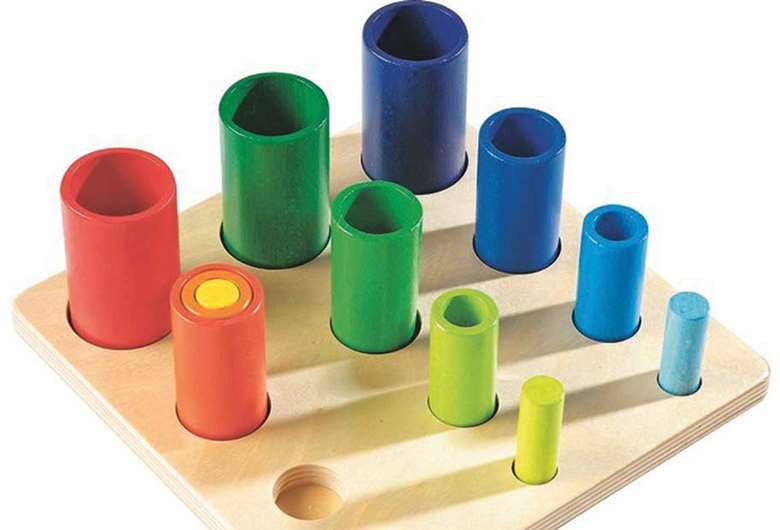
Children need to develop an understanding of size and opposites in order to make sense of the world around them. Practitioners can support this area of mathematical development, which fits into 'shape, space and measure' within the Early Years Foundation Stage (2012), by providing plenty of opportunities to talk about and compare the size of objects or people around them. This can be done through books or hands-on exploration of resources such as Russian dolls, stacking boxes or collections of animals, eggs and spoons or shells.
Linda Pound, freelance early years curriculum consultant, says, 'Big and little is the first comparison that children make, followed by boy and girl. Opposites are about defining territory, where the child is asking, "What are we dealing with here?" It's an early form of categorisation. Comparing is a fundamental part of mathematical thinking.'
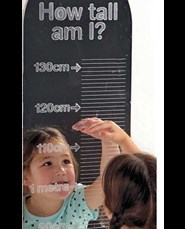 STARTING YOUNG
STARTING YOUNG
Young children like to talk about big and small so it is an easy subject to bring up in the earliest conversations with them. Ms Pound explains, 'The aim should be to provide opportunities to broaden children's vocabulary. For example, when a child says, "He's bigger than me", you reply, "Yes, you're right. He is taller than you."
'When it comes to active learning, children should be given plenty of opportunities to explore collections of different sorts of toy, frogs, ducks, cars or shells. Practitioners can support children's use of descriptive and comparative vocabulary as they discuss size, colour, pattern and shape.
'Collections should come in a variety of sizes,' explains Ms Pound. 'Offering objects that are small and heavy alongside those that are big and light can provide opportunities to explore the relationship between size and weight. For example, this bear is taller than that one, but that one is much fatter. However, collections that tackle size, weight and height are more challenging because there are no easy answers. Graded resources like nesting boxes, sets of sieves or measuring spoons are very useful.'
Ms Pound advises practitioners to look out for illustrations of anomalies of size. 'These are often found in adverts, for example, a very small car on the road or a very large foot on top of a house. Use them as a discussion point and maybe even make a scrapbook of examples. It's perfectly alright for children to talk about big and little, but practitioners need to keep introducing language to describe and differentiate bigness.'
ACTIVITIES AND RESOURCES
Here are some useful activities and resources for helping children to understand size:
- Begin introducing size to younger children through traditional stories such as The Three Bears, Jack and the Beanstalk and Three Billy Goats Gruff. Create role-play areas of the three bears' cottage using the set of three different-sized Wooden Carved Out Seats (£49.99), Billy Goats Gruff Bridge (£199), the giant's kitchen with extra large cooking tools like the Giant Whisk (£9.99) and the Giant Beechwood Spoon (£7.95). Or create miniature fairy worlds with the Small Wooden Kitchen (£9.25), the Wooden Small Bedroom (£6.95) and the Wooden Small Living Room (£9.25). All of the above are available from Cosy Direct on 01332 370152.
- Provide resources that help children measure and compare their height and shoe size. Reflections on Learning's How Tall Am I? acrylic mirror (£29.99), enables children to see themselves as they measure their height - www.reflectionsonlearning.co.uk. Or try the Peel and Stick Chalkboard Height Chart (£16.99) from www.tts-group.co.uk, the Foot, Hand and Object Measure (£11.99) or the Big Tape Measure (£9.99), both from www.earlyyearsresources.co.uk
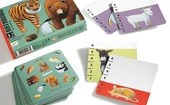
- Explore size and make links with capacity through messy, sand and water play. Try the Pack of Cascading Bowls (£19.99), the set of 12 Juicy Scoops (£11.95), or the Bamboo Shoot Lengths (£52.95), all from Cosy. Graduated Cylinders (£14.99) from www.reflectionsonlearning.co.uk provide an opportunity to look at height and volume of different liquids. The EYR Water Fun Pack (£23.99) from www.earlyyearsresources.co.uk includes whisks, funnels, measuring cups and spoons in graduated sizes.
- Playing with construction sets inside and out, especially block play, gives children loads of opportunities for exploring and talking about size. Try the Building Block Cart (£204.95), the Nature Building Blocks (£21.99), from Cosy. Or children can arrange the Thinnest to Thickest Staircase block (£43.80) from www.wesco-eshop.co.uk.
- Collections of natural materials are good for arranging, sorting by size, measuring and ordering. Try the bundle of different-sized Creative Star Cuisenaire Sticks (£30 for 30) or the Maths Cone selection (£4.50) from Cosy Direct. The Shells - Large Pack (£42.99) from www.reflectionsonlearning.co.uk contains a rich variety of shapes and sizes of shells, which would be ideal for sorting into size order. Try using them with the Jumbo Magnifiers (£18.99) from www.earlyyearsresources.co.uk.
- The Egg and Spoon Collection (£60) from www.playtoz.co.uk, contains an unusual selection of egg and spoon-shaped objects carefully picked for their contrast in textures, weights, properties, colour, pattern and size. The Ball and Hoop Collection and the Hide and Seek Collection (both £60) from Play to Z are also sensory-rich resources that will help with children's hand-on exploration of size.
- TTS Group's Metallic Pebble Collection (£62.95) can be used for construction and counting and sorting, or children could try putting the nesting Sparkle Cylinders (£64.95) into size order. Children can learn about varying sizes and determine which ball goes into which size container, matching size and colour, in the Scoop and Sort Collection (£59.95) also from www.tts-group.co.uk
- For counting and sorting opportunities outdoors, try the set of nine different sized Stainless Steel Balls (£45) from www.mindstretchers.co.uk or the Maths Blocks Set (£43), also from Mindstretchers, which contains wood cut to specific lengths that are proportional and makes learning about measures easy and fun.
- Mindstretchers' Motivational Maths set - Snake Set (£50) includes six large soft snakes, a wooden snake and an assortment of different-sized rubber snakes. It also includes two measuring tapes and a black sorting mat.
- Also in the range is the Wheel Set (£40) and the Ducks and Chicks Set (£30). Materials Through Eggs (£50) provides opportunities to explore size, materials, colour, design and pattern.
- Children love to use real tools to explore size and capacity. Try the Pound Shop Tape Measures Set (£5.25), the Real Spirit Level (£1.49) or the Mini Real Life Ladders Set of Two (£69.95), all from Cosy Direct.
- Games and puzzles focusing on size include the card game Batanimo (£6) from www.wesco-eshop.co.uk, where the child with the largest animal wins the set, or Shapes Tray Puzzle Pipes (£14.50), also from Wesco UK, which helps children develop a sense of progression from smallest to largest. Pyramidix (£42) from www.ascoeducational.co.uk is a three-dimensional jigsaw puzzle for developing and understanding of numbers and quantities and the Early Maths Activity Centre (£44.40), also from Asco, contains four illustrated activity mats, plus 36 easy-grip elephants in three sizes.
- The Comparing Sizes Concept Kit (£34.99) from www.earlyyearsresources.co.uk, includes ten themed mats in size order and 30 miniature objects in three sizes (small, medium and large) that encourage children to sort, match, sequence and classify. Counting Bears (£14.99), also from Early Years Resources, contains 96 bears in three sizes, three weights and six colours.
BOOK CORNER
- Once There Were Giants by Martin Waddell
- Dear Zoo by Rod Campbell
- Where's My Teddy? By Jez Alborough
- Maisy Big, Maisy Small by Lucy Cousins
CASE STUDY: ALFRETON NURSERY SCHOOL
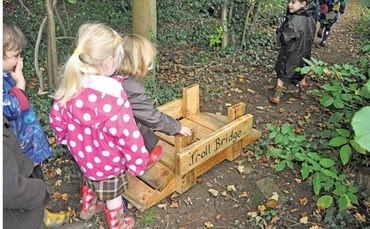
Making pizza is just one of the activities that helps children at Alfreton Nursery School in Derbyshire to understand the concept of size.
Jane Blant, nursery nurse, says, 'Having a "real" experience is a very positive approach to emphasising opposites and shape. We are constantly reinforcing mathematical language and concepts to the children in all areas of the nursery. A typical example is when we bake pizzas.
'We introduce the activity with a song about a pizza hut. The children then weigh out the ingredients for the pizza, taking turns to mix and count out the spoonfuls of flour. If using eggs, we look at the properties of the egg inside and out and compare sizes. The children then knead the pizza dough and we look at the size and shape of our knuckles.
'We then roll out the dough and we discuss its shape. All the time we are discussing the sizes of the tools use and comparing and contrasting ingredients as we talk about the big and small mushrooms; pieces of cheese; long, thin slices of pepper, and round tomatoes.'


